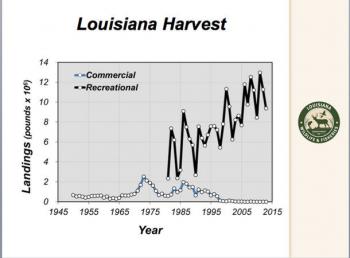
Submitted Chart/Courtesy of LSU Manship News Service
Speckled trout population trending down
Louisiana anglers trying to catch speckled trout suffered a frustrating summer in 2014, but this dip in production does not represent a problem with the fish’s population in state waters, according to information presented to the Louisiana Wildlife and Fisheries Commission at its monthly meeting.
In fact, the data actually showed an upward trend in the state’s speckled-trout harvest, despite suffering a steady drop from 13 million pounds of the fish landed in 2011 to less than 10 million pounds in 2014.
“What we’re looking for here is how things change over time,” Harry Blanchet, saltwater finfish program manager for the department, said. “Things now look like they have in the past.”
Blanchet presented the culmination of the department’s stock assessment of speckled trout, which the commission requested earlier this year. The overall assessment did not include data from 2014 because the year is not over.
Most of the data indicated speckled-trout stocks in Louisiana are as healthy now as they’ve ever been.
One of the final slides in the presentation displayed the relationship between harvest and spawning stock biomass — the total population of female speckled trout capable of reproducing.
It showed overfishing has occurred in a number of years, but the state failed to reach maximum benefit because harvest was too light in a nearly equal number of years.
As a result, the average of all the collected data added together indicates Louisiana remains in what department biologists consider the safe zone.
“If we move too far (into the safe zone), what we’re actually doing is keeping more fish in the water that could be harvested under current standards,” Assistant Secretary Randy Pausina told the commission. “We manage for maximum benefit.”
The annual landing graph was characterized by a number of peaks and valleys, but the average trend line continues to show an increase in fish harvested.
Unfortunately, Pausina said this seemingly positive trend may be a result of the rapid degradation of our coast.
“In a nutshell, as habitat declines, it’s actually beneficial for some time for a species,” he said. “It’s after you get over that hill that it’s bad. In some areas, we might be there. As the marsh erodes, it creates more habitat for a time. Then, eventually, (the habitat) gets smaller and smaller.”
Not every piece of data Blanchet presented showed positive trends. He told the commission that spawning stock biomass has steadily decreased since the state experienced a peak in 2008.
This reduction could indicate more of the coast’s energy is invested in small, immature fish, or it could be the sign of a bigger problem, especially if data showed a downward trend in recruitment as well.
Recruitment refers to the number of fish that survive juvenile years and become large enough to be legally harvested.
Luckily, Blanchet also showed data on gill-net harvests by the state between April and September every year dating back to 1986, including 2014.
The chart indicated a rating of 1.0 as a typical year, and in both 2013 and 2014, most catches made came in either at or above that benchmark, indicating strong recruitment. In fact, the harvest in the department’s 1-inch-mesh gill nets was higher than it’s ever been.
Recruitment peaked in 2000, and despite a few peaks and valleys, it has stayed relatively stagnant since.
“The recruitment that we have seen has not declined,” Blanchet said. “It is consistent within the range.”
After the presentation, Commissioner Ed Swindell asked Blanchet if he saw any reason to justify a reduction in Louisiana’s speckled-trout harvest.
Blanchet responded saying the state’s ability to maintain recruitment was critical to keeping harvest numbers up.
“If the recruits are there, it’s up to you guys to determine what to do with those recruits,” Blanchet said. “That’s what fisheries regulation is about. You can leave them all in the water, you can manage for big fish, or you can manage for opportunities.
“From a biological perspective, we’re in fine shape.”
Moving forward with this information, the department plans to recommend speckled-trout management which will vary by basin depending on each area’s health.
Currently, most of the state limits anglers to 25 speckled trout each with a 12-inch minimum size limit. Anglers in southwest Louisiana adhere to a 15-fish-per-angler limit due to a regulation implemented by the commission without an endorsement from the department.
This basin-by-basin management will be made easier by the coast-wide LA Creel Survey implemented by the department this year. The survey, which replaced the federal government’s MRIP survey at the start of 2014, stations department personnel at popular marinas and fishing spots throughout Louisiana so they can intercept anglers to discuss their effort and measure their catch.
“One of the challenges of the MRIP program is that it was always on a statewide estimate basis,” Blanchet said. “Soon, we’ll be able to do estimates by basin. We’ve been asking for this for a long time from the national program. That kept getting kicked down the road. We finally kicked back.”
Blanchet said it will take time for that data to mean something, as there is currently nothing to compare it to. But eventually, trends will begin to reveal themselves and further help the department make decisions regarding harvest regulation.
“It will take at least four years for us to get that basin-level harvest data,” he said. “The first year or two, there’s no context to it. Once you have enough (data) points, then it starts to become a lot more informative.”
- Log in to post comments
